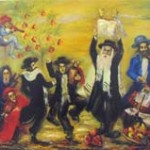A creative religion
 Some of the most popular Jewish observances are creations of Jewish history.
Some of the most popular Jewish observances are creations of Jewish history.
Solemn occasions like Yizkor and Yahrzeit are deeply embedded in Jewish practice, but are not ordained in the Torah. Nor are celebrations like Simchat Torah and Tu BiSh’vat.
Within the parameters of Jewish law, these and other traditions have come into being at different stages of Jewish history and have seized the imagination of our people to such an extent that you cannot imagine Jewish life without them.
What especially commended Simchat Torah to the Jewish mind and heart was its democratic character.
The fact that the scholars and the ordinary people alike responded to the opportunity to show their love for the Torah truly made it possible for Judaism to be, as the Torah itself puts it, morashah k’hillat Yaakov – “an inheritance of the congregation of Jacob” (Deut. 33:4).
Judaism always set its face against any suggestion that it was interested only in the spiritual or intellectual elite.
Hence the Talmud, in listing the six questions that will be put to each of us at the moment we seek to enter the World to Come, includes among them, “Did you set aside time for Torah?” – not, “Were you a great scholar?, but “Did you give time to your Judaism and make an effort?” (Shabbat 31a).
Even more pointedly, the Jewish folk saying is, “Nine rabbis cannot make a minyan – but ten cobblers can”.



